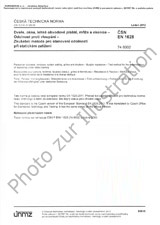Wir benötigen Ihre Einwilligung zur Verwendung der einzelnen Daten, damit Sie unter anderem Informationen zu Ihren Interessen einsehen können. Klicken Sie auf "OK", um Ihre Zustimmung zu erteilen.
ČSN ETSI EN 303405-V1.1.1 (875179)
Land Mobile Service; Analogue and Digital PMR446 Equipment; Harmonised Standard covering the essential requirements of article 3.2 of Directive 2014/53/EU
Name übersetzen
NORM herausgegeben am 1.12.2017
Informationen über die Norm:
Bezeichnung normen: ČSN ETSI EN 303405-V1.1.1
Zeichen: 875179
Katalog-Nummer: 503146
Ausgabedatum normen: 1.12.2017
SKU: NS-802347
Zahl der Seiten: 72
Gewicht ca.: 216 g (0.48 Pfund)
Land: Tschechische technische Norm
Kategorie: Technische Normen ČSN
Kategorie - ähnliche Normen:
Die Annotation des Normtextes ČSN ETSI EN 303405-V1.1.1 (875179):
V1.1.1
The present document covers the minimum characteristics considered necessary in order to avoid harmful interference and to make acceptable use of the available frequencies for analogue and digital PMR446 equipment in the land mobile service.
PMR 446 equipment is hand portable (no base station or repeater use); short range peer to peer mode; uses integral antennas only; effective radiated power not exceeding 500 mW and angle modulated.
The band from 446,0 MHz to 446,2 MHz is designated for the use of analogue PMR 446 with a channel plan based on 12,5 kHz spacing where the lowest carrier frequency is 446,006 25 MHz.
The band from 446,1 MHz to 446,2 MHz is designated for the use of digital PMR 446 with a channel plan based on 6,25 kHz and 12,5 kHz spacing where the lowest carrier frequencies are 446,103 125 MHz and 446,106 25 MHz respectively.
The band from 446,0 MHz to 446,2 MHz is designated for the use of digital PMR 446 with a channel plan based on 6,25 kHz and 12,5 kHz spacing where the lowest carrier frequencies are 446,003 125 MHz and 446,006 25 MHz respectively as of 1 January 2018.
Analogue PMR446 equipment operating in the frequency range from 446,1 MHz to 446,2 MHz uses more robust receivers as specified in ETSI TS 103 236 [2].
As defined in ECC/DEC/(15)05 [i.6] Analogue PMR446 equipment operating in the frequency range from 446,0 MHz to 446,1 MHz should use more robust receivers as specified in ETSI TS 103 236 [2] or equivalent technical specifications when placed on the market as of 1 January 2017.
As defined in ECC/DEC/(15)05 [i.6] all analogue and digitial PMR 446 radio equipment should have reception capability and equipment having Push-To-Talk (PTT) functionality capable of being latched ´on´ should apply a 180 seconds maximum transmitter time-out; equipment having no Push-To-Talk (PTT) functionality should apply a 180 seconds maximum transmitter time-out and VOX (Voice activation exchange) control.
The present document assumes that digital PMR446 equipment using 6,25 kHz channel spacing is compliant with ETSI TS 102 490 [4].
The present document assumes that digital PMR446 equipment using 12,5 kHz channel spacing is compliant with ETSI TS 102 361-1 [5].
The present document contains requirements to demonstrate that "... Radio equipment shall be so constructed that it both effectively uses and supports the efficient use of radio spectrum in order to avoid harmful interference" and that "....radio equipment supports certain features ensuring access to emergency services" [i.7].
In addition to the present document, other ENs that specify technical requirements in respect of essential requirements under other parts of article 3 of the Radio Equipment Directive [i.7] may apply to equipment within the scope of the present document
Normansicht ČSN ETSI EN 303405-V1.1.1 (875179)
Empfehlungen:
Aktualisierung der technischen Normen
Wollen Sie sich sicher sein, dass Sie nur die gültigen technischen Normen verwenden?
Wir bieten Ihnen eine Lösung, die Ihnen eine Monatsübersicht über die Aktualität der von Ihnen angewandten Normen sicher stellt.
Brauchen Sie mehr Informationen? Sehen Sie sich diese Seite an.




 Cookies
Cookies
